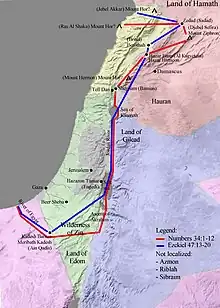قادش (الكتاب المقدس)
قادش (بالعبرية: קָדֵשׁ)،[1] هو اسم موقع جغرافي ذُكر في العديد من المواضع من الكتاب المقدس العبري، حيث يصف موقع أو عدة مواقع تقع جنوب أرض كنعان ومملكة يهوذا.[2][3]

يذكر الكتاب المقدس قادش أو قادش برنيع في عدد من الإصحاحات، مما يجعله موقعًا مهمًا في الروايات المتعلقة بالأصول الإسرائيلية. وقد كانت قادش الموقع الرئيسي لمعسكر الإسرائيليين أثناء تجولهم في صحراء صين (سفر التثنية 1:46)، وكذلك المكان الذي تم إرسال الجواسيس الإسرائيليين منه إلى كنعان (العدد 13: 1-26)، ومنه كانت أول محاولة فاشلة للاستيلاء على كنعان من قادش، وضرب موسى الصخرة بعصاه فانفجرت منها المياه في قادش، وماتت أخته مريم وأخيه هارون ودُفنا بالقرب من مكان يُدعى قادش. وأرسل موسى مبعوثين إلى ملك إدوم من قادش، وطلب الإذن للسماح للإسرائيليين باستخدام الطريق الملوكي العابر عبر أراضيه، وهو ما رفضه ملك إدوم.
وفقًا للمؤرخ اليهودي يوسيفوس، فإن قادش مرتبط بمدينة البتراء في الأردن.[4]
كما أن قادش برنيع هي سمة أساسية في التعريف التوراتي للحدود الجنوبية لأرض إسرائيل،[5] وبالتالي فإن تحديدها هو المفتاح لفهم كل من الحدود المثالية والجيوسياسية لإسرائيل القديمة.
المراجع
- Brown, Francis, S. R. Driver, and Charles A. Briggs, eds. (1907). A Hebrew and English Lexicon of the Old Testament. New York: Houghton Mifflin. pp. 871-874; Koeler-Baumgartner 3:1072-1078; TDOT 12:521-545.
- Charles Trumbull (1884). Kadesh-Barnea: Its Importance and Probable Site, 24-25.
- Kadesh Barnea (קדש ברנע), whence the spies were sent to search out the Land of Canaan, near Canaan's southern border, is identified by يوسابيوس القيصري (Onomasticon) and by Jacob Sussmann as being البتراء in Arabia, the southernmost extent of the boundary of Israel in the 4th century BCE (See: Jacob Sussmann, The Boundaries of Eretz-Israel, Tarbiẕ (Academic Journal), pub. by: Mandel Institute for Jewish Studies, Jerusalem 1976, p. 239). Cf. يوسيفوس فلافيوس, عاديات اليهود (iv.vii.§1) who names five قوم مدين kings who formerly governed the region, but by the 1st century CE the place had already come under the possession of the Arabs: "Of these there were five: Ochus and Sures, Robees and Ures, and, the fifth, Rekem; the city which bears his name ranks highest in the land of the Arabs and to this day is called by the whole Arabian nation, after the name of its royal founder, Rekeme: it is the Petra of the Greeks" (Loeb Classical Library). Others have identified Kadesh Barnea, not with Petra, but with Ein el Qudeirāt, or what is also called Tell Qudeirāt near Quseimah in the region of the central النقب, now belonging to Egypt (Ben-David Ben-Gad Hacohen, 1998 - pp. 28–29), arguing that Reḳam (Petra) in Mishnah Gittin was not considered the Land of Israel, while Reḳam of Ǧayāh is listed as a frontier city of the Land of Israel. (See also Y. Aharoni, "Kadesh-barnea," Encyclopaedia Biblica, 7:39-42; R. Cohen, "Kadesh-Barnea," New Encyclopedia of Archaeological Excavation 3:843–847).
- Flavius، Josephus. "Antiquities of the Jews (iv.vii.§1)". Loeb Classical Library, London 1961. DOI:10.4159/DLCL.josephus-jewish_antiquities.1930. مؤرشف من الأصل في 2019-12-17.
- Zecharia Kallai, "The Southern Border of the Land of Israel — Pattern and Application", Vetus Testamentum XXXVII 4 1987, 438-445.
- بوابة علم الآثار
- بوابة الشرق الأوسط القديم
- بوابة اليهودية
- بوابة الإنجيل
- بوابة الأديان